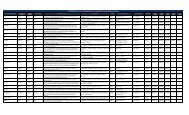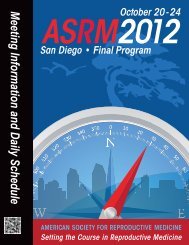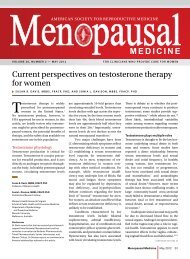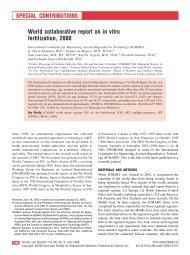scientific program • symposia - American Society for Reproductive ...
scientific program • symposia - American Society for Reproductive ...
scientific program • symposia - American Society for Reproductive ...
You also want an ePaper? Increase the reach of your titles
YUMPU automatically turns print PDFs into web optimized ePapers that Google loves.
MATERIALS AND METHODS: Conservative management<br />
with observation until maturity, symptom control, septum<br />
resection and minimal surgical intervention. However, in<br />
the setting of the anamolous genital tract, imaging can<br />
be misguiding and surgical intervention to relieve patient<br />
symptoms may be warranted.<br />
__________________________________________________________<br />
V-18 5:28 PM<br />
LAPAROSCOPIC RESECTION OF A RECTOVAGINAL NODULE<br />
OF ENDOMETRIOSIS IN ASSOCIATION WITH A UTERINE<br />
MALFORMATION.<br />
N. Vulliemoz, E. McVeigh, T. Child. Nuffield Department of<br />
Obstetrics and Gynaecology, University of Ox<strong>for</strong>d, Ox<strong>for</strong>d,<br />
Ox<strong>for</strong>dshire, United Kingdom.<br />
OBJECTIVE: We present the case of a 25 year-old P0 woman<br />
who was referred to our clinic <strong>for</strong> severe cyclical pelvic pain,<br />
dyspareunia and dyschezia without per rectum bleeding.<br />
On examination a 4-cm full thickness rectovaginal nodule<br />
of endometriosis was seen with excruciating tenderness<br />
on palpation. The cervix and the rest of the vagina looked<br />
normal. The rectal examination was normal. The MRI<br />
confirmed the rectovaginal nodule and the uterus was<br />
described as bicornuate. After discussing the possible risks<br />
associated with the surgery, the patient decided to undergo<br />
a laser laparoscopy with excision of the rectovaginal<br />
nodule.<br />
DESIGN: Using CO2 laser, adhesiolysis is started. Both ureters<br />
are dissected from the side wall to prevent injury. The<br />
bowel is separated from the posterior wall of the uterus<br />
until the rectovaginal nodule is identified. It is vaporized<br />
with the CO2 laser. As the lesion involves the full thickness<br />
of the vaginal wall, we open the vagina to excise the<br />
nodule. The vagina is closed using simple interrupted<br />
stitches of Monocryl 2.0. At the end of the surgery, there is<br />
no bleeding and the rectovaginal space has been freed.<br />
The patient was discharged day 3 post operatively without<br />
complication. She was reviewed 6 weeks later with almost<br />
complete resolution of symptoms. At 6 months there was no<br />
symptomatic recurrence.<br />
MATERIALS AND METHODS: In 2007 our Department<br />
published a retrospective study looking at urological and<br />
colorectal complications following surgery <strong>for</strong> rectovaginal<br />
endometriosis. The cohort included 128 women with<br />
histologically confirmed rectovaginal endometriosis<br />
who underwent laparoscopic laser surgery. Major<br />
complications occurred in four women (3%). Three women<br />
developed fistulae and ureteric damage occurred in one<br />
woman. There<strong>for</strong>e radical laser excision of rectovaginal<br />
endometriosis is a safe procedure that can give long-term<br />
pain relief. The potential serious complications necessitate<br />
careful and extensive counselling be<strong>for</strong>e the surgery.<br />
__________________________________________________________<br />
V-19 5:42 PM<br />
ROBOTIC APPLICATIONS IN BENIGN ADNEXAL PATHOLOGY.<br />
A. R. Gargiulo, D. Shah, S. S. Srouji. Center <strong>for</strong> Infertility and<br />
<strong>Reproductive</strong> Surgery, Brigham and Women’s Hospital/<br />
Harvard Medical School, Boston, MA.<br />
OBJECTIVE: This video illustrates our recent surgical<br />
experience with two separate cases of benign tumors of<br />
the adnexa: a fibroadenoma of the tubal infundibulum<br />
and a recurrent mature cystic teratoma of the ovary. In<br />
both of these cases the use of the da Vinci robot was<br />
felt to contribute distinct advantages in terms of fertility<br />
VIDEO PROGRAM<br />
100<br />
preservation over our standard laparoscopic techniques.<br />
DESIGN: A 22 year old nuliiparous woman was referred to<br />
us following a diagnostic laparoscopy where a presumably<br />
benign solid tumor of the infundibulum was identified. We<br />
per<strong>for</strong>med a robot-assisted enucleation of the tumor with<br />
microsurgical instrumentation and complete preservation of<br />
the lumen.<br />
A 30 year old nulliparous and woman with history of bilateral<br />
open cystectomy and left laparoscopic stripping of mature<br />
teratomata was referred to us <strong>for</strong> a recurrence in the<br />
right ovary observed in preparation <strong>for</strong> an ART cycle. We<br />
per<strong>for</strong>med a robot-assisted laparoscopic stripping entirely in<br />
a specimen pouch with no spill and with sparing of normal<br />
ovarian tissue and hilar vessels.<br />
MATERIALS AND METHODS: Use of the da Vinci robotic<br />
plat<strong>for</strong>m in these two delicate cases made a difference<br />
- in our opinion - in terms of our ability to preserve fertility.<br />
Microsurgical capabilities allowed the pristine reconstruction<br />
of a severely affected tubal infundibulum. Similarly, the pitch<br />
and yaw at the wrist of standard robotic instruments allowed<br />
us to com<strong>for</strong>tably complete an entire teratoma stripping<br />
procedure in a specimen pouch and to limit coagulation of<br />
the ovarian cyst bed.<br />
It is our considerate opinion as experienced minimally<br />
invasive reproductive surgeons that the above procedures<br />
could certainly be per<strong>for</strong>med by many with conventional<br />
laparoscopy, but by very few with the same level of<br />
accuracy and tissue preservation that is allowed by the<br />
robotic plat<strong>for</strong>m.<br />
This footage was intentionally submitted without verbal<br />
commentary to let the images speak <strong>for</strong> themselves.<br />
__________________________________________________________<br />
V-20 5:48 PM<br />
ROBOTICALLY ASSISTED OVARIAN TRANSPLANTATION.<br />
M. Bedaiwy, E. Barakat, M. Catenacci, L. Carvalho, T.<br />
Falcone. Obstetrics and Gynecology, Cleveland Clinic<br />
Foundation, Cleveland, OH.<br />
OBJECTIVE: To describe a technique <strong>for</strong> robotically assisted<br />
transplantation of hemiovaries.<br />
DESIGN: The ovarian cortex of the left over ovary was<br />
removed and the fresh raw surface will be the recipient<br />
site. The frozen hemovaries was thawed and orthotopically<br />
transplanted to a freshly created medullary surface of<br />
the remaining ovary using the surgical robot (Da-Vinci).<br />
Transplantation was completed using 8-0 prolene stitches. 2<br />
weeks later, the ovarian grafts were examined <strong>for</strong> viability,<br />
harvested and fixed <strong>for</strong> histopathological examination. The<br />
video could seen using the following link:<br />
files.me.com/lehtinenvideography/kr8rd5.<br />
MATERIALS AND METHODS: Robotically assistance may<br />
facilitate transplantation of fresh or frozen-thawed hemiovaries.<br />
It could also minimize the worm ischemia time. 8-0<br />
or less prolene sutures should be used.<br />
__________________________________________________________<br />
V-21 6:02 PM<br />
A SUCCESSFUL TWIN PREGNANCY AFTER ADNEXAL TORSION<br />
ON EMBRYO TRANSFER DAY: THE IMPORTANCE OF A QUICK<br />
DIAGNOSIS.<br />
F. A. Padilla, S. Chedid, F. Ikeda. Chedid Grieco Medicina<br />
Reprodutiva, Sao Paulo, Brazil.<br />
OBJECTIVE: To report a case of unilateral adnexal torsion<br />
8 hours after embryo transfer and the successful of the<br />
twin pregnancy in this cycle due to quickly diagnosis and








